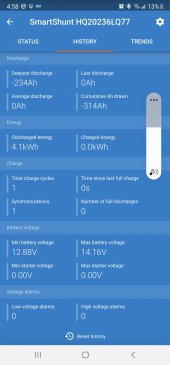I recently installed a simple system for a detached garage. (I didn't do it to save money). It powers the opener and two LED lights. I did this project
as an experiment in order to learn about solar and how it works. Again, this is not about money.
As it is summer, I have the back door of my townhouse open, and I ran an extension cord to the inverter (35 feet) and am powering my computer system
with it during the day. Two 24" monitors, Intel NUC PC (very small), modem, and UPS. The system easily keeps up and the battery stays full.
System: 100W panel, 100ah battery, and 1500W pure sine wave inverter.
I can see how many amp hours it produces during the day, but I would like to somehow break that down further. Is there a way to do that? If I want to see how
much money the electricity that is is generating is worth at the end of the day, how do you convert amp hours to KWH?
Has anyone seen a simple spreadsheet or tracking tool in order to keep a record of daily output?
Thanks.
as an experiment in order to learn about solar and how it works. Again, this is not about money.
As it is summer, I have the back door of my townhouse open, and I ran an extension cord to the inverter (35 feet) and am powering my computer system
with it during the day. Two 24" monitors, Intel NUC PC (very small), modem, and UPS. The system easily keeps up and the battery stays full.
System: 100W panel, 100ah battery, and 1500W pure sine wave inverter.
I can see how many amp hours it produces during the day, but I would like to somehow break that down further. Is there a way to do that? If I want to see how
much money the electricity that is is generating is worth at the end of the day, how do you convert amp hours to KWH?
Has anyone seen a simple spreadsheet or tracking tool in order to keep a record of daily output?
Thanks.



